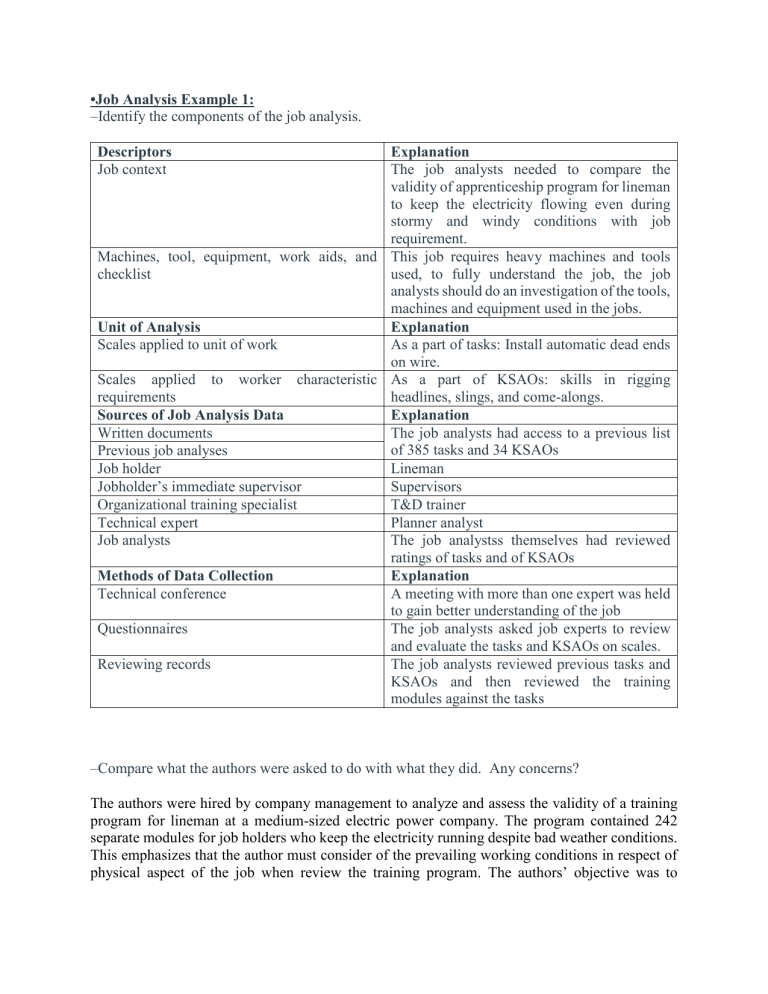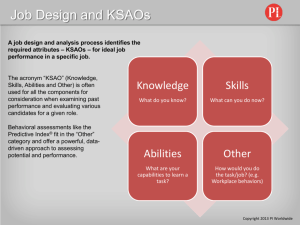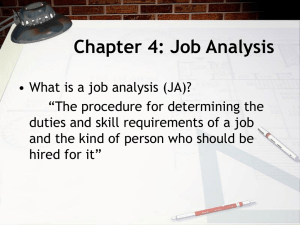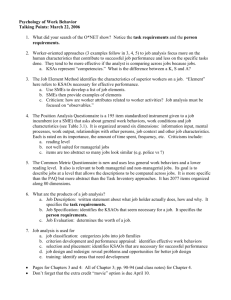
•Job Analysis Example 1: –Identify the components of the job analysis. Descriptors Job context Explanation The job analysts needed to compare the validity of apprenticeship program for lineman to keep the electricity flowing even during stormy and windy conditions with job requirement. Machines, tool, equipment, work aids, and This job requires heavy machines and tools checklist used, to fully understand the job, the job analysts should do an investigation of the tools, machines and equipment used in the jobs. Unit of Analysis Explanation Scales applied to unit of work As a part of tasks: Install automatic dead ends on wire. Scales applied to worker characteristic As a part of KSAOs: skills in rigging requirements headlines, slings, and come-alongs. Sources of Job Analysis Data Explanation Written documents The job analysts had access to a previous list of 385 tasks and 34 KSAOs Previous job analyses Job holder Lineman Jobholder’s immediate supervisor Supervisors Organizational training specialist T&D trainer Technical expert Planner analyst Job analysts The job analystss themselves had reviewed ratings of tasks and of KSAOs Methods of Data Collection Explanation Technical conference A meeting with more than one expert was held to gain better understanding of the job Questionnaires The job analysts asked job experts to review and evaluate the tasks and KSAOs on scales. Reviewing records The job analysts reviewed previous tasks and KSAOs and then reviewed the training modules against the tasks –Compare what the authors were asked to do with what they did. Any concerns? The authors were hired by company management to analyze and assess the validity of a training program for lineman at a medium-sized electric power company. The program contained 242 separate modules for job holders who keep the electricity running despite bad weather conditions. This emphasizes that the author must consider of the prevailing working conditions in respect of physical aspect of the job when review the training program. The authors’ objective was to compare and contrast the training contents with the job requirements and this was their driving force to choose the choice of methods. This particular job analysis was required for the purpose of “Training” which means to support job holders to perform better in their job. According to Morgeson et.al (2019), the development of training can be determined by the key KSAOs which are required for job holders to successfully perform their tasks. Thus, in order to approach their given task, the authors met with training staff to understand the project and give attention to any issues if needed but most importantly, they decided that tasks and KSAOs would be the only thing to focus on this project. The first source of data available to the authors was a previous list of tasks and KSAOs which were provided to them in written documents. More importantly, the authors were able to form a group of experts including job holders, supervisors, training specialist and technical expert to assist them in reviewing and evaluating the tasks and KSAOs based on their experience and knowledge. After gathering all information from the company’s perspectives and the authors’ perspectives, they reviewed the training modules against the tasks in order to complete the assessment on the training program. In my opinion, the authors had performed a solid and thorough work by setting a specific goal at the beginning. They identified main duties involve, involved people in the company and sought for the assistance from job experts. Throughout their process, it is clearly that they focus on identifying KSAOs and tasks, however they carried out to understand the tasks first before KSAOs because it is crucial that the tasks must be established first before determining KSAOs. Additionally, they collected data from multiple sources: written documents, focus group, questionnaires, evaluation and analyses which had made their report more accurate and trustworthy. Nevertheless, one of my concern is that “Literature Review” was not applied to gain an initial understanding of the job. The sources can be varied but most famously is from job description but there was no record showing that they have reviewed the job description. According to Mathis and Jackson (2008), job description is a systematic that contains detailed summary of job tasks, duties and responsibilities, a key document used by employees and managers to assure an understanding of what the job incumbent is expected to do to perform the job therefore job description should align with tasks and KSAOs. If there is a review of job description, we will have more savvy on the tasks and KSAOs. Moreover, the methods of data collection should sufficient for their research, maybe more methods could have been applied for example directly observe job incumbents performing the job duties, work sample or job segments. This is essential because it will for identify the physical requirements, physical work context and environmental conditions especially in this case where the lineman sometimes had to perform their job during stormy and windy conditions. In conclusion, the authors had performed an excellent job analysis by focusing on identifying tasks and KSAOs as well as collecting data from a large sample, of course, there are several components that could be further considered to collect the data such as review literature and observing. Combining several data collection methods will balance the strengths and weaknesses of each method and will be able to provide both quantitative and qualitative data to explain in detail all of the elements involved in the job and the qualifications needed to perform the duties. Consequently, the report will be more credible and accountable •Job Analysis Example 2: –Identify the components of the job analysis. Descriptors Organizational philosophy and structure Explanation A large hospital delivering mental health services to inpatients and outpatients Licensing and other government -mandated Typically, incumbents related to healthcare requirements industry must hold a certain kind of certificate. Thus, job analysts must identify the licenses and/or certifications required for this job. Responsibilities The job analysts must develop valid MQs for Pharmacy Technician position with the original requirement was:” two years of experience in assisting a registered pharmacist in the compounding and dispending of prescriptions” Personal job demands Based of personal job demands to identify whether several jobs at the hospital had an adverse effect on hiring chances of minority groups Work activities The job analysts must fully understand what does the job do. In this particular case, basically job holder will have to Compound and Dispense of prescriptions Worker characteristic requirements The job analysts must identify skills, knowledge communication, abilities to perform this job. Unit of Analysis Explanation Duties The job analysts collected different MQs for PT to determine the new acceptable MQs Tasks Check patient records to determine drug allergies and interactions Scales applied to worker characteristic Ability to communicate orally with requirements pharmacists/ other healthcare professionals Sources of Job Analysis Data Explanation Previous job analyses The job analysts decided to use other MQs for PT to set their fundamental objective. Organizational training specialist Job analysts had a meeting with key staff at the hospital and HR to kick off the project Other organizational units Technical experts Job analysts assembled panels of 6-9 job experts to assist with developing MQs Methods of Data Collection Explanation Technical conference Questionnaires Group interviews A meeting with more than one expert of the job was held to better understand the reasons and requirement of the job. The job analysts had experts to evaluate and rate task and KSAs Two groups of experts were assembled to discuss the tasks and KSAs respectively. From that, the job analysts will distinguish candidates who are not acceptable for the job and who are barely acceptable. –Identify and evaluate the MQs for a job of your choice. The MQs developed for the position of a high school math teacher could be identified as follow: - Candidate must hold a bachelor’s degree in Mathematics from an accredited institution Must hold a professional teacher license from any state or enrolled in a program to obtain a professional teachers license. Candidate shall have at least 3 years of successful math teaching experience. Must comfortable working with students especially those who one or two levels behind Must have excellent communication skills and a friendly, approachable personality Generally, MQs are baseline set of skills and other requirements that an applicant must possess in order to eligible for the job. The MQs above are measurable and objective, clearly identifies the bare minimum for knowledge, experience and certifications that applicant must have to apply for the job. KSAs were clearly listed out so job applicant understands the minimum expectations from hiring perspectives. Moreover, the MQs were written in language to indicate that the MQs are mandatory, detailed when describing required experience (number of years experience, field of experience,….) and specified the credentials required to be considered as a candidate (a bachelor’s degree in Mathematics). References: Harter, J. K., Schmidt, F. L., & Keyes, C. L. M. (2003). Well-being in the workplace and its relationship to business outcomes: A review of the Gallup studies. In C. L. M. Keyes & J. Haidt (Eds.), Flourishing: Positive psychology and the life well-lived (pp. 205–224). American Psychological Association. Saziye Gazioglu & Aysit Tansel.,(2006) Job satisfaction in Britain: individual and job related factors, Applied Economics, 38:10, 1163-1171, DOI: 10.1080/00036840500392987




